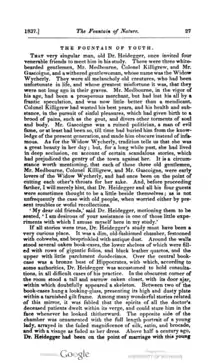Dr. Heidegger's Experiment
"Dr. Heidegger's Experiment" is a short story by American author Nathaniel Hawthorne. The story is about a doctor who claims to have been sent water from the Fountain of Youth. Originally published anonymously in 1837, it was later published in Hawthorne's collection Twice-Told Tales, also in 1837.
| "Dr. Heidegger's Experiment" | |
|---|---|
 | |
| Author | Nathaniel Hawthorne |
| Original title | "The Fountain of Youth" |
| Country | United States |
| Language | English |
| Genre(s) | fiction, short story |
| Published in | The Knickerbocker, Vol. IX, p. 27 |
| Publication date | January 1837 |
Plot
Dr. Heidegger invites four elderly friends to participate in an experiment in his mysterious, gloomy study. He shows them a withered rose that he claims is fifty-five years old. He then displays a vase, a gift from an acquaintance, that contains a generous quantity of sparkling water. Heidegger explains that this bewitching water is from the legendary Fountain of Youth, near Lake Macaco (now known as Lake Okeechobee, in Florida). The water wondrously causes the old rose to bloom again when it is dropped into it.
Dr. Heidegger's friends become cautiously intrigued. They wish to taste the water, hoping it will restore their youth and give them an opportunity to live life again, free from the mistakes they made when they were young. As Heidegger watches, they anxiously drink the water. Their youth restored, they begin acting as fatuously as they did in their prime. Soon, the three men of the group begin competing for the attention of the now-youthful and beautiful widow. While experiencing their newfound youth, however, a tall ominous mirror in the study reflects an image of the four guests as still being elderly and feeble. The vase is accidentally smashed as the men fight over her, and its miraculous water is lost. The guests' transformation only lasts for minutes, and therefore returns them to their original old age. To obtain more of the enchanted water, the four test subjects determine to travel to Florida to find the Fountain of Youth.
Characters
- Dr. Heidegger - An aged and wise physician who is the protagonist of the story.
- Colonel Killigrew - A man who, throughout his life, has had many self-indulgent, sinful pleasures.
- Mr. Medbourne - A once-rich merchant who lost most of his fortune in speculation.
- Mr. Gascoigne - A politician whose career was ruined by his corruption.
- Widow Wycherley - A formerly beautiful woman loved by the three gentlemen (Colonel Killigrew, Mr. Medbourne, Mr. Gascoigne).
- Sylvia Ward- A youthful woman whose portrait hangs upon a wall in the study. She was supposed to marry Dr. Heidegger but died the day before their marriage. (The rose Dr. Heidegger uses in his experiment is one he received from Sylvia for their wedding.)
Publication history
The story was first published anonymously as "The Fountain of Youth" in the January 1837 issue of Lewis Gaylord Clark's The Knickerbocker magazine in New York.[1] It was included later that year in Hawthorne's collection Twice-Told Tales. Edgar Allan Poe reviewed the second edition of the collection in 1842 and wrote that "Dr. Heidegger's Experiment" was "exceedingly well imagined and executed with surpassing ability. The artist breathes in every line of it."
Adaptations
- Dr. Heidegger's Experiment, an episode of the old-time radio program Favorite Story. It first aired on May 15, 1948, and was hosted by Ronald Colman. It starred John McIntire as Dr. Heidegger, Lurene Tuttle, Earle Ross, Arthur Q. Bryan, and Norman Field. It was selected by Robert Walker as his favorite story.[2]
- Dr. Heidegger's Fountain of Youth, chamber opera by Jack Beeson and Sheldon Harnick (1979) [3]
- Britannica Classic: Nathaniel Hawthorne's Dr. Heidegger's Experiment, adapted as a short film, dramatized by the Encyclopædia Britannica Educational Corporation in 1969. Available for viewing online at http://www.britannica.com/EBchecked/topic/1685292/Doctor-Heideggers-Experiment. (It stars Peter Brocco.)
- It was included, with significant changes, as the first segment of the 1963 movie Twice-Told Tales starring Vincent Price
References
- Miller, Perry. The Raven and the Whale: The War of Words and Wits in the Era of Poe and Melville. New York: Harvest Book, 1956: 14.
- "ST55: Dr. Heideggers Experiment by Favorite Story" Castroller.com Archived August 8, 2014, at the Wayback Machine
- "Opera versions of Hawthorne's works, scores, librettos, and vocal recordings" ibiblio.org 5 August 2011
External links
| Wikisource has original text related to this article: |
- eText on Project Gutenberg (Included in Twice Told Tales)
- A Brief Article on NYU's database site
 Dr. Heidegger's Experiment public domain audiobook at LibriVox
Dr. Heidegger's Experiment public domain audiobook at LibriVox